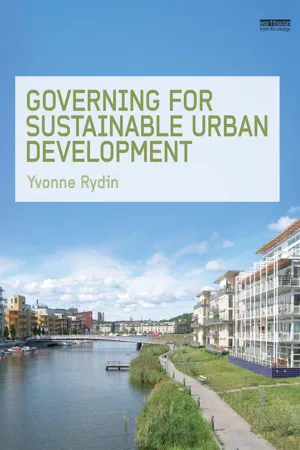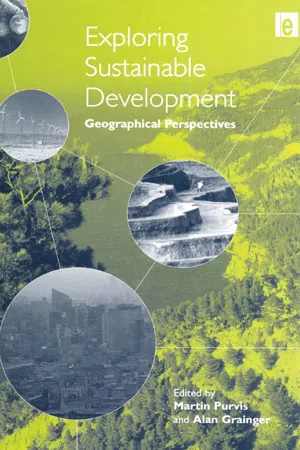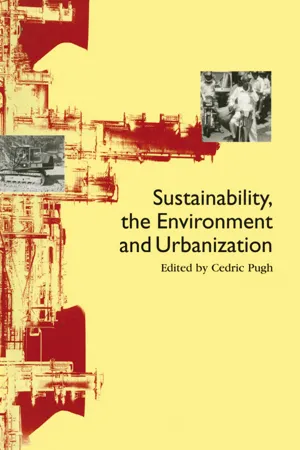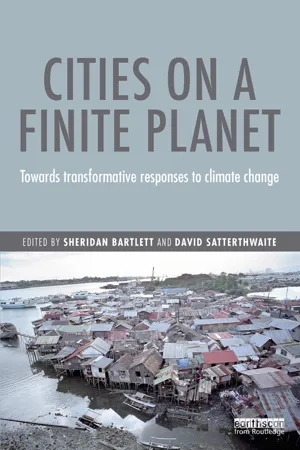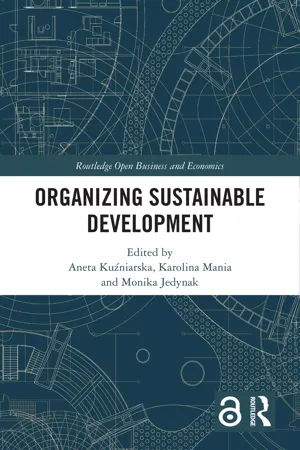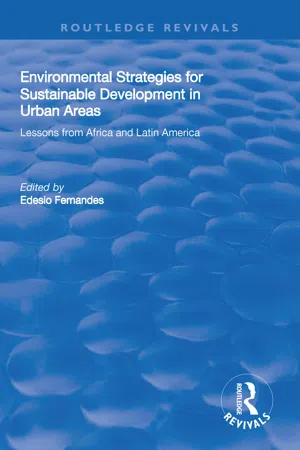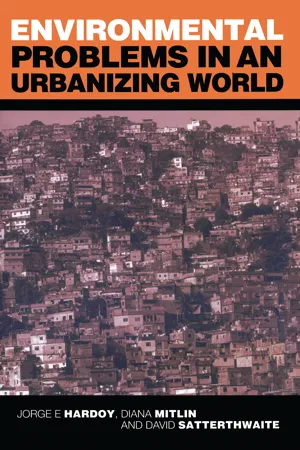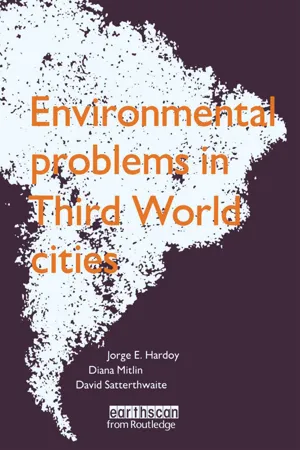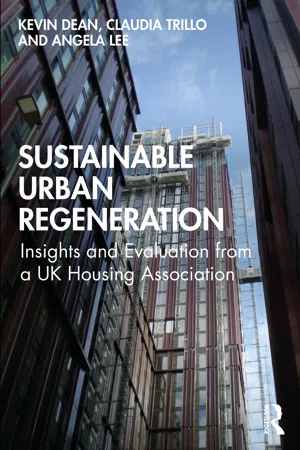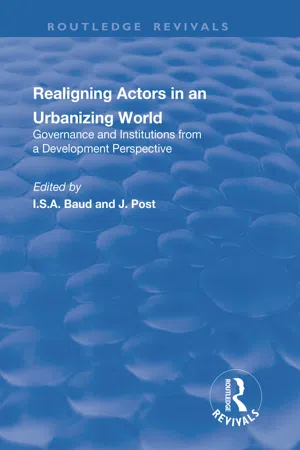Geography
Sustainable Urban Development
Sustainable urban development refers to the planning and management of cities in a way that meets the needs of the present without compromising the ability of future generations to meet their own needs. It involves creating cities that are environmentally friendly, socially inclusive, and economically viable. This approach aims to promote efficient land use, reduce pollution, and enhance quality of life for urban residents.
Written by Perlego with AI-assistance
Related key terms
Related key terms
1 of 4
Related key terms
1 of 3
12 Key excerpts on "Sustainable Urban Development"
- eBook - ePub
- Yvonne Rydin(Author)
- 2012(Publication Date)
- Routledge(Publisher)
1 Sustainable Development and the Urban Agenda IntroductionSustainable development is now widely acknowledged to be an important policy goal, possibly the most important policy goal. This curious and not always well-understood mix of environmental protection, sustained economic activity and social welfare has become the public face of much policy activity. Its profile has been raised by the continuing and growing evidence of the scale and significance of climate change, by the enduring nature of profound social inequalities and even by the reversal of economic fortunes as economies slide into recession.Sustainable development offers the prospect of a very different world and this includes our urban areas, our towns and cities and the built environments that they comprise. Urban areas are central to all aspects of sustainable development. They are centres of economic wealth-creation and yet, at the same time, locations of social deprivation. They can be associated with all sorts of environmental degradation – loss of green space, air pollution, greenhouse gas emissions linked to energy use, waste generation and excessive water consumption to name but a few key aspects – and yet offer the scope for considerable resource efficiencies.This raises the prospects of changing our urban areas to contribute more fully to sustainable development rather than undermine it. Change can, of course, occur within the existing physical fabric but there has been increasing interest in using the processes of urban development to drive change. Understood broadly, urban development can encompass new build, demolition and rebuild, refurbishment, regeneration and area improvement. These all have considerable potential for reshaping the built environments of urban areas.This book looks at the role that urban development can play in delivering sustainable development. It considers how activity at the urban scale is related to the broader concept of sustainable development (the remainder of Chapter 1 ) and elaborates what Sustainable Urban Development means at the scale of the building, the development site, and the urban area or region (Chapter 2 ). After an account of the market processes that drive urban development (Chapter 3 ), the main emphasis of the book is on how processes of governing can shape the delivery of Sustainable Urban Development. Chapters 4 and 5 - eBook - ePub
Exploring Sustainable Development
Geographical Perspectives
- Martin Purvis, Alan Grainger(Authors)
- 2013(Publication Date)
- Routledge(Publisher)
Geography has a long record of studying both the environmental impacts and sustainability of human activity, and the equity with which the costs and benefits of development are distributed. In this sense, geographical attention to what is now termed sustainable development long predates discussions inspired by the 1987 Brundtland Report or the ensuing 1992 UN Conference on Environment and Development (UNCED) in Rio de Janeiro. Geography’s record of applied work – in fields ranging from environmental management to access to welfare services – is also consistent with the desire to improve both the human condition and the health of the environment that motivates the study of sustainable development (for different perspectives on applied geography, see Burton and Kates, 1965; Pacione, 1999a; Peet, 1977; Stamp, 1963) Moreover, thinking geographically – which involves attention to the needs and circumstances of particular communities; to the spatial patterning of human activity; to the relationships that connect the human and environmental spheres; and to the links between individual localities and wider systems – has the potential to enhance and extend existing attempts to understand the theory and practice of sustainable development. In a context that demands a broad-based and integrative understanding, geography’s intellectual diversity and capacity for synthesis constitute genuine strengths. Geography does not have answers for all of the questions posed by sustainable development; but, arguably, it has the right attitude to advance knowledge in this field. The chapter now turns, therefore, to consider the attempts already made to foster explicit engagement between geography and sustainable development.Engaging with Sustainable Development
Putting sustainable development on the geographical agenda
Development – what it means, how it can best be achieved and what its consequences are – has always ranked high amongst geography’s concerns (for recent overviews see Crush, 1995a; Dicken, 2003; Knox and Agnew, 1998; Potter et al, 1999; Power, 2003). The advent of the concept of sustainable development potentially marks a new phase in this record of engagement. Initial enthusiasm is evident in commentaries such as Wilbanks (1994), which argues that closer links between geography and sustainable development would be beneficial, both in increasing understanding of sustainability and in giving geography a renewed disciplinary coherence and sense of purpose. Indeed, there are echoes here of earlier calls for geography to champion a more explicit ethic of social and environmental justice (see, for example, Kates, 1987; Smith, 1977; Stoddard, 1987).During the 1990s, sustainable development gained a place in geography’s disciplinary lexicon (McManus, 2000). Its study is now part of the geography syllabus in UK schools (Grimwade et al, 2000) and the concept is explored in general textbooks aimed at an undergraduate audience (for example, Cloke et al, 1999; Daniels et al, 2001; Johnston et al, 2002). Geographers have also produced accessible accounts that review evolving ideas about sustainable development, often paying particular attention to its attempted translation into practice (Adams, 2001; Elliott, 1999; Middleton et al, 1993). These broad-ranging studies are complemented by treatments of sustainable development in particular geographical contexts, both generic and specific (Bowler et al, 2002; Haughton and Hunter, 1994; Jussila et al, 2001). In turn, debates about sustainable development and efforts to create composite indices of sustainability have begun to influence geographical studies of spatial differentiation (for example, Straussfogel, 1997). Such work is novel in attempting the integrated assessment of spatial variation in the state of the environment, individual welfare and the strength of social cohesion, alongside more conventional economic measures of development. - eBook - ePub
- Robert Krueger, Tim Freytag, Samuel Mössner, Robert Krueger, Tim Freytag, Samuel Mössner(Authors)
- 2019(Publication Date)
- SUNY Press(Publisher)
No matter which moniker one chooses—Sustainable Urban Development, LA 21, smart growth, compact urban development—sustainable development has been adopted as a set of policy goals in many cities. This does not mean that the process of urbanization has become more “sustainable” in recent times. Sure, we have more mass transit nodes, more green buildings, more viable ecosystems in our cities than before. This is all good. And what’s interesting is that while ecological modernization has influenced macroeconomic change, it has influenced urbanization too. The value of being green is viewed by many cities as a foregone conclusion. Freiburg, Germany, proudly calls itself the greenest city in Europe, as does Växjö, Sweden. Despite the accolades and media attention these cities have had, they have not realized what it means to be a sustainable city. The actions of these cities have brought economy and environment closer together in ways aligned with the norms established by Brundtland. Many commentators have noted that for many cities the single most important element in a city’s sustainability effort revolves around environmental concerns (Portney, 2003). As we pointed out above, these environmental aspects coupled nicely with economic development visions, which made them palatable for city policymakers and boosters. Fully integrating, or having environment-led development remains an elusive goal, but in the last round of urban regeneration, these two goals articulated by Brundtland and operationalized at the local level have more closely aligned visions when, a generation earlier, they were seen to be at odds with one another.In this section, we present the broader urban political economic context in which Sustainable Urban Development exists. Indeed, Sustainable Urban Development has found spatial expression in the context of broader urban economic drivers. It may seem ironic that the “sustainable city” sits so comfortably within the tableau of the “neoliberal city.” The appearance is both an illusion and a construction of reality. As Agyeman (2013) reminds us, it is an illusion because, as a set of principles , Sustainable Urban Development fails to deliver on its commitment to social equity and economic security. It is also a construction of reality - eBook - ePub
- Cedric Pugh(Author)
- 2014(Publication Date)
- Routledge(Publisher)
This discussion about the territorial boundaries for sustainable development has particular importance for the debate about cities. This chapter is also about sustainable development and cities rather than sustainable cities. A concentration on ‘sustainable cities’ focuses too much on achieving ecological sustainability within increasingly isolated ‘eco-regions’ or ‘bio-regions’. Seeking ‘sustainable cities’ implies that each city has to meet the resource needs of the population and enterprises located there from its immediate surrounds. But the goals of sustainable development are the meeting of human needs within all cities (and rural areas) with a level of resource use and waste generation within each region and within the nation and the planet that is compatible with ecological sustainability. It is unrealistic to demand that major cities should be supported by the resources produced in their immediate surrounds but entirely appropriate to require that consumers and producers in high-consumption, high waste cities reduce their level of resource use and waste and reduce or halt the damaging ecological impacts of their demands for fresh water and other resources on their surrounds.Although the discussions and recommendations about ‘sustainable cities’ have much of relevance to reducing the depletion of environmental capital caused by production and consumption in cities in the North, they concentrate too much on individual city performance. What is more important for sustainable development is the local, national and international frameworks needed to ensure the achievement of sustainable development goals worldwide, including the appropriate frameworks for cities.What sustainable development implies for city authoritiesA commitment to sustainable development by city authorities means adding additional goals to those that are the traditional concerns of local authorities. Meeting development goals have long been a central responsibility of city and municipal authorities. Their objectives generally include a desire for greater prosperity, better social conditions (and fewer social problems), basic services, adequate housing and (more recently) better environmental standards within their jurisdiction. This does not imply that city and municipal authorities need be major providers of basic services – and they can act as supervisors and/or supporters of private or community provision. - eBook - ePub
Cities on a Finite Planet
Towards transformative responses to climate change
- Sheridan Bartlett, David Satterthwaite(Authors)
- 2016(Publication Date)
- Routledge(Publisher)
Box 2.1 , provides a normative view of development. Arising out of the World Commission on Environment and Development in 1987, this term was a corrective to the conventional view of development as economic growth or “modernity”, adding an environmental perspective. Key to this notion of sustainable development is the idea that development in the present should not compromise development for future generations. This has been built upon in recent discussions around the formulation of the Sustainable Development Goals (or SDGs), the successor goals to the UN Millennium Development Goals. The proposed definition here refers to meeting a “just balance among the economic, social and environmental needs of present and future generations” (United Nations 2014, p. 2). In urban contexts, the reduction of risk is to be realized through poverty eradication, including the provision of safe, accessible and affordable urban infrastructure, and an increase in the number of cities and human settlements adopting and integrating plans for adaptation, mitigation and resilience to disasters, backed by national commitments to mitigate and adapt to climate change through the United Nations Framework Convention on Climate Change. The Goals themselves are viewed as integrated across their social, economic and environmental dimensions, with risk reduction therefore embedded in broader sets of actions to promote sustainable development.The term sustainable development has a long pedigree, however, and has been critiqued for its appropriation by the same conventional paradigm it attempted to replace (Pelling 2011). Sustaining existing levels of environmental degradation also potentially compromises the needs of future generations, and some commentators prefer to talk of “regenerative urban development”, which would restore the ecological functions of cities (World Future Council 2010). This could occur as part of urban regeneration projects and in planning for growing cities of the global South, where it is possible to establish regenerative systems from the outset, thereby “leapfrogging” conventional, modernist development pathways. - eBook - ePub
- Aneta Kuźniarska, Karolina Mania, Monika Jedynak, Aneta Kuźniarska, Karolina Mania, Monika Jedynak(Authors)
- 2023(Publication Date)
- Routledge(Publisher)
These concepts also bring together discourses from different fields, as illustrated by the broad view taken in the SDGs (Ramos et al., 2020 ; UN General Assembly, 2015). Although definitions of sustainable development vary, often causing conceptual confusion that makes it difficult to put the concept into practice (Sheehy & Farneti, 2021), the SDGs are widely recognised as a normative compass for sustainable development policy-making (Fukuda-Parr, 2016 ; Koff et al., 2022). The sustainable development strategy is interdisciplinary and refers to all dimensions of sustainability. To implement it, it is necessary to convince people of the value of the idea of sustainability (Pawłowski, 2008). Changes in people’s attitudes are referred to as the internal dimension of sustainability or change from within (Horlings, 2015). A matter of great importance is environmental education, which must integrate into topics other than just nature. Adopting this more complex perspective should encourage and enable management educators to take into account conflicting yet interrelated issues and open the door to more creative teaching, research and theory-building, as well as ethical dilemmas in decision-making (Moratis & Melissen, 2022). With the climate crisis worsening, following a pandemic that is delaying the realisation of the SDGs (The Sustainable Development Goals Report 2021, 2021), during the Russian aggression in Ukraine, it is difficult to predict the actual long-term effects of human activity. Global problems have reached a scale and level of complexity that makes it difficult, if not impossible and to solve them within the assumed timeframe. Hence the need to take a broader view of sustainability and consider its many dimensions. References Allen, A. (2009). Sustainable cities or sustainable urbanisation? Palette UCL’s Journal of Sustainable Cities, 1. Ávila, C., Cedano, K., & Martínez, M. (2017) - eBook - ePub
Environmental Strategies for Sustainable Developments in Urban Areas
Lessons from Africa and Latin America
- Edesio Fernandes(Author)
- 2019(Publication Date)
- Routledge(Publisher)
Moreover, the urban environment permits the efficient mobilization of people’s energies and resources, enhances the income-generating ability of the informal sector and promotes education and skills training. Greater participation in the urban economy leads to the creation of a skilled and literate workforce. Thus, the promise of cities is to liberate the mass of people from poverty, hunger, disease and premature death.What can make cities more sustainable
A deteriorating urban environment is the enemy of sustainable development. Concern for the urban environment is not simply a concern for the health of urban populations or for the hypothetical rights of unborn generations: it is a concern for making sustainable development possible and manageable. A few fundamental points can be mentioned:- A more efficient management of the city environment is needed. A concern with reduced use of natural resources per unit of output should be enforced (for example, through public transport policies addressing mobility needs and environmentally sound industrial development), as should policies enhancing savings in public services (for example, a demand-oriented approach to water supply management), increased attention to operation and maintenance of public facilities, improved governance and political will towards sustainability principles.
- Improved land use planning within urban and peripheral urban areas, thus avoiding the occupation of disaster prone areas and the encouragement of balanced high and low density uses.
- Adoption of policies that are conducive to a more equitable access of city services (water, energy, transport, waste disposal, educational and health facilities) by the urban poor as well as to more participatory decision-making processes.
What UNDP is doing to promote the sustainability of cities
UNDP has adopted an approach to urban problems that links sustainable human development with economic productivity. It encourages the adoption of strategies that promote equitable growth, gender equality and participatory development. The main goal is to enlarge people’s choices by assisting in the development of their capabilities, improving their access to employment, credit, health and education, and increasing their participation in economic, social and political activities. UNDP promotes human development in urban areas by means of providing support for actions in five priority areas, namely: poverty alleviation; strengthening urban local government and administration; improving the urban environment; providing urban infrastructure, shelter and services; and promoting the private sector and NGOs. - eBook - ePub
Environmental Problems in an Urbanizing World
Finding Solutions in Cities in Africa, Asia and Latin America
- Jorge E. Hardoy, Diana Mitlin, David Satterthwaite(Authors)
- 2013(Publication Date)
- Routledge(Publisher)
But in the long term, all cities will suffer if the aggregate impact of all cities’ production and their inhabitants’ consumption draws on global resources at unsustainable rates and deposits wastes in global sinks at levels that disrupt the functioning of ecosystems and global cycles. Adding a concern for ‘ecological sustainability’ on to existing development concerns means setting limits on the rights of city enterprises or consumers to use scarce resources and to generate non-biodegradable wastes. This has many implications for citizens, businesses and city authorities. Perhaps the most important for cities in high-income nations and for the more prosperous cities in middle-income nations is the role of city and municipal authorities in promoting the needed delinking of high standards of living/quality of life from high levels of resource use and waste generation. The different environmental emphases that can be given within any ‘sustainable development policy’ is made clear by Graham Haughton’s unpicking of the different aspects of environmental equity. He suggests that we think of sustainable development as seeking to reconcile five different dimensions of environmental equity (see Box 8.2). Many proponents of ‘sustainable development’ concentrate on only one or two of these aspects and may indeed promote actions that go against the other dimensions, as in forcing local populations off land they have long utilized (and may even own) to create ‘wildlife’ reserves or ‘green belts’. However, while Figure 8.1 and the checklist in Box 8.2 with its five different aspects of environmental equity are useful for governments in developing policies to contribute towards sustainable development goals, the actual policies and the priorities must be developed locally, so they respond to local circumstances, including local opportunities and constraints - eBook - ePub
- Jorge E. Hardoy(Author)
- 2024(Publication Date)
- Routledge(Publisher)
- ‘Renewable resources’. Human use of some renewable resources (such as the direct use of solar power or its indirect use through wind or wave power) does not deplete the resource. But many renewable resources (especially crops and trees) are renewable only within finite limits set by the ecosystem within which they grow. Fresh water resources are also finite; in the case of aquifers, human use often exceeds their natural rate of recharge and as such is unsustainable.
The term sustainable is used both for particular projects/activities and in reference to larger systems (perhaps city-wide, nation-wide or worldwide). It is useful to differentiate between the two applications of the term since both are important in considering sustainable development and cities. Simple inter-relationships between specific development activities (for instance, expanding a piped-water supply or developing a sanitary landfill site) and natural resource-use can be assessed and judged using the criterion of sustainability. Alternatively, the focus can be much broader, concerned with large aggregates and systems of activities. The first approach is concerned with making a single part of the system sustainable. The second approach has a different focus, recognising that it is difficult to make all activities sustainable, and that what is important is that the sum (or net effect) of the activities within a specific area is sustainable. In general, our focus is on the second of these contexts, ensuring that urban systems (and the economies and societies of which they are part) are sustainable, rather than specific urban projects, or even cities. The successful achievement of sustainable development requires society to establish institutions which are capable of ensuring that individual projects add up to an acceptable aggregate outcome without demanding such stringent conditions on individual projects that they inhibit the achievement of development goals.Cities and Ecological Sustainability
This disaggregation of sustainable development into its two components simplifies its discussion in regard to cities. The sustainability component is the impact of each city (or rather of the producers and consumers located within the city) on environmental capital: local and global sinks, renewable resources, and non-renewable resources. The development component is the performance of each city and its institutions in meeting its inhabitants’ development needs; as previous chapters have stressed, this also has an important environmental component since the quality of the home, work, neighbourhood and city environment, and the extent to which the inhabitants are protected from biological pathogens and chemical pollutants in the water, air, soil or food or other environmental hazards has a major influence on the health and well-being of the population.20 - eBook - ePub
Sustainable Urban Regeneration
Insights and Evaluation from a UK Housing Association
- Kevin Dean, Claudia Trillo, Angela Lee(Authors)
- 2022(Publication Date)
- Routledge(Publisher)
2 Urban regeneration and sustainable developmentDOI: 10.1201/9781003043881-2Introduction
This chapter demystifies the subject domains of sustainable development and urban regeneration and additionally covers the history and definitions of urban regeneration. It then proceeds to look at the links between housing and urban regeneration, housing and health, as well as housing and its relationship with each part of the triple bottom line (Elkington et al., 2007 ). The economic climate and its effect on housing associations is looked into in more depth, as are the corresponding problems and potential solutions. The importance of housing policies and the negative impact the new economic climate could determine is considered within the broader framework of the Sustainable Development Goals. At this point, purpose, history and definitions of sustainable development are made clear, together with definitions of ‘weak’ versus ‘strong’ sustainability, models of sustainable development, ‘capitals’, the recent UN Habitat III conference and its shift towards sustainable cities, and finally, sustainable development and its links with urban regeneration.Urban regeneration
The population of those living in urban areas is increasing. The United Nations (2018) states that around 55% of the world’s population is living in urban areas and predicts that by 2050, this number will increase to 68% – similar to the UN’s earlier predictions published in 2012. Indeed, the United Nations (2012a) additionally predicts that the land conversion to urban areas will triple by 2030 and asserts that 21st-century global urban trends have “taken human civilisation into unknown territory” with half the world’s population living in urban areas for the first time in history, stating that by 2030, the world urban population is expected to be around 5 billion people, whilst the level of urbanisation will rise from what was 52% in 2011 to a figure of 67% in 2050 (UN, 2012b; UN Habitat, 2011). Evans et al. (2016 - eBook - ePub
- David Satterthwaite(Author)
- 2021(Publication Date)
- Routledge(Publisher)
Agenda 21 and its prescriptions for solving global environmental problems at the local level are well known. Building on Agenda 21, the Habitat Agenda, signed by 180 nations at the recent Habitat II conference in Istanbul, will also strongly influence the way we run cities. It states: ‘Human settlements shall be planned, developed and improved in a manner that takes full account of sustainable development principles and all their components, as set out in Agenda 21 … We need to respect the carrying capacity of ecosystems and preservation of opportunities for future generations. Production, consumption and transport should be managed in ways that protect and conserve the stock of resources while drawing upon them. Science and technology have a crucial role in shaping sustainable human settlements and sustaining the ecosystems they depend upon.’ 10 What, then, is a sustainable city? Here is a provisional definition: A ‘sustainable city’ is a city that works so that all its citizens are able to meet their own needs without endangering the well-being of the natural world or the living conditions of other people, now or in the future. This definition concentrates the mind on fundamentals. In the first instance the emphasis is on people and their needs for long-term survival. Human needs include good quality air and water, healthy food and good housing; they also encompass quality education, a vibrant culture, good health care, satisfying employment or occupation, and the sharing of wealth; as well as factors such as safety in public places, supportive relationships, equal opportunities and freedom of expression; and meeting the special needs of the young, the old or the disabled - eBook - ePub
Re-aligning Actors in an Urbanized World
Governance and Institutions from a Development Perspective
- I. Baud, J. Post(Authors)
- 2018(Publication Date)
- Routledge(Publisher)
A great deal has been written about concepts of sustainability and sustainable development, ranging from conceptions of social, economic, and political sustainability to more specific concepts of ecological sustainability. An excellent summary of such discussions in the context of development studies is provided by an article written by Mitlin and Satterthwaite (1996). They distinguish ecological sustainability on the basis of the following criteria; minimizing the use or waste of non-renewable resources, sustainable use of renewable resources, and keeping wastes from cities within the absorptive capacity of local and global sinks. The element of ‘development’ includes social, economic, and political needs for current and future generations. Together these elements form the potential for ‘sustainable development’ (cf. Mitlin and Satterthwaite, 1996, pp. 31-32). Their definitions are used as starting points in this chapter. Sustainability and sustainable development are seen as policy goals that form the backdrop against which to assess current resource flows and the natural systems from which they emanate, competing demands for resource flows, the organization of their transformation and distribution, and the issues of governance regulating them. Given the current state of affairs - societal, political, scientific, and with respect to technological innovations - it is more realistic to talk about striving for a transition towards a more sustainable way of urban life, or ‘the transition to sustainability’ (O’Riordian, 1998). Realizing completely ecologically sustainable development is still a Utopian goal.Sustainability - as the word is used in this chapter - has a number of key features. Firstly, there are absolute physical limits to growth, imposed by the ‘limited carrying capacity of ecosystems, the recuperative efficiency of natural resources, and the availability of raw materials’ (Sachs et al.
Index pages curate the most relevant extracts from our library of academic textbooks. They’ve been created using an in-house natural language model (NLM), each adding context and meaning to key research topics.
Explore more topic indexes
Explore more topic indexes
1 of 6
Explore more topic indexes
1 of 4
